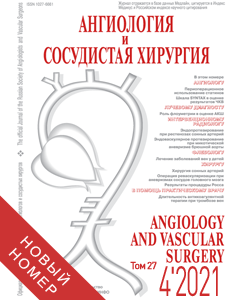Journal «Angiology and Vascular Surgery» •
2013 • VOLUME 19 • №4
Immediate and remote results of surgical treatment of patients presenting with pathological tortuosity of internal carotid arteries and accompanying ocular ischaemic syndrome
Gavrilenko A.V.1, Kuklin A.V.1, Kisleva G.N.2, Abramyan A.V.1, Omarrzhanova I.I.1
1) Department of Vascular Surgery, Russian Scientific Centre of Surgery named after Academician B.V. Petrovsky under the Russian Academy of Medical Sciences
2) Department of Ultrasound, Moscow Eye Diseases Research Institute named after Helmgoltz, RF Ministry of Public Health, Moscow, Russia
The article deals with the data concerning the efficacy of reconstructive operations and conservative treatment in patients presenting with pathological tortuosity of internal carotid arteries. The study included a total of 63 patients. The diagnostic algorithm was as follows: studying the haemodynamics of the internal carotid arteries, assessing the neurological status, and the methods of examining the eye. The patients were subdivided into two groups: Group One consisted of operated on patients (n=37) and Group Two comprising patients treated conservatively (n=26). The patients according to the neurological status were subdivided as follows: an asymptomatic course in 25 (39.7%) patients, transitory ischaemic attacks in 18 (28.6%) patients, dyscirculatory encephalopathy in 12 (19 %) patients, and stroke in 8 (12.7%) patients. Ophthalmological symptomatology was predominantly manifested by fits of amaurosis fugax in 19 (30.2%) patients and processes of maculodystrophy in 49 (77.8 %) patients. We assessed the immediate (day 30) and remote (1 year) results of conservative and surgical treatment. Group One patients demonstrated cessation of the amaurosis fugax attacks, improvement of the acuity of vision by 0.1 and more, enlargement of the borders of the field of vision, disappearance of scotomas, as well as arrest of the processes of maculodystrophy. Patients with transitory ischaemic attacks and dyscirculatory encephalopathy changed to the category of asymptomatic patients. In Group Two patients the dynamics of the neurological status was negative and the patients continued to experience fits of amaurosis fugas. The dynamics of the opthalmological symptomatology was weakly pronounced.
KEY WORDS: pathological tortuosity of the internal carotid arteries, chronic cerebrovascular insufficiency, ocular ischaemic syndrome, amaurosis fugax.
P. 119
ARCHIVES MAGAZINE
2021 (Vol.27)
2020 (Vol.26)
2019 (Vol.25)
2018 (Vol.24)
2017 (Vol.23)
2016 (Vol.22)
2015 (Vol.21)
2014 (Vol.20)
2013 (Vol.19)
2012 (Vol.18)
2011 (Vol.17)
2010 (Vol.16)
2009 (Vol.15)
2008 (Vol.14)
2007 (Vol.13)
2006 (Vol.12)
2005 (Vol.11)
2004 (Vol.10)
2001 (Vol.7)
2000 (Vol.6)
1999 (Vol.5)
1998 (Vol.4)
1997 (Vol.3)


